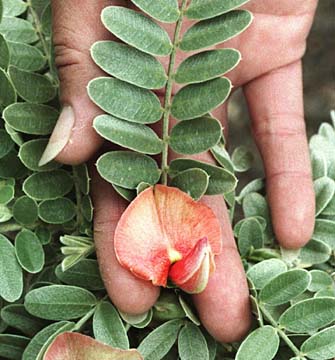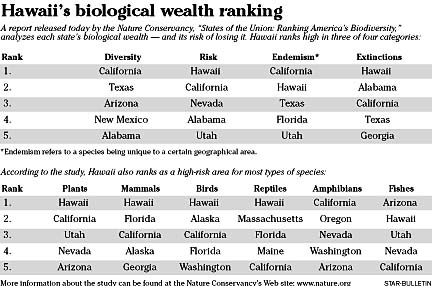


|
Hawaii ranked most at risk among the 50 states in two out of four categories of a scientific study of biological wealth and risk released today by the Nature Conservancy. Isles No. 1 in extinction risk
A study says Hawaii has the
most species in biological dangerBy Diana Leone
dleone@starbulletin.com"The main reason Hawaii ranks so high is because of our isolation," said Mark White, director of conservation programs for the Nature Conservancy of Hawaii.
"We have 10,000 unique species between plants and insects," White said.
"Hawaii might have ranked even higher on the diversity side if (the report) had looked at insects," he added.
The report, "States of the Union: Ranking America's Biodiversity," was prepared for the Nature Conservancy by NatureServe, which provides scientific information about rare and endangered species and threatened ecosystems.
It drew from ongoing species inventories conducted by state programs to rank states and the District of Columbia on several key biological characteristics including diversity of species; distinctiveness of the flora and fauna (endemism); levels of rarity and risk; and species already lost to extinction. Hawaii ranked No. 1 in the categories of extinctions and risk (for surviving species) and No. 2 in endemism.

Risk patterns among states -- as reflected by the proportion of a state's species considered imperiled or vulnerable -- highlight Hawaii, where 63 percent of species are at risk, and California, with 29 percent of species at risk. In a breakdown of risk by species categories, Hawaii ranked No. 1 in risk for plants, mammals, birds and reptiles and No. 2 in fishes.Ever since the first Polynesian settlers of Hawaii arrived and introduced new plants and animals to the islands, "there's been an enormous impact on the species that originated here," White said.
Though many Hawaii species already are extinct, White said, "the good news is that half the state has still relatively intact native forests."
One of the promising trends of the past decade has been the formation of watershed protection partnerships among state, federal and local government agencies, private landowners and conservation organizations, White said.
The partnerships "greatly leverage the effort we'd be able to do on our own," he said.
White said the Conservancy spends about $3 million a year for conservation programs in Hawaii. "I think we're turning a corner."
The other big focus for Hawaii is trying to stop dangerous interlopers like brown tree snakes or fire ants from getting into the state, White said.
"This report holds both hope and peril," said Steve McCormick, president of the Nature Conservancy. "As an important snapshot of the biological health of our nation, it shows the extraordinary richness of the flora and fauna across all 50 states. But it also serves as a stark reminder that too many of these species are at risk of vanishing forever."